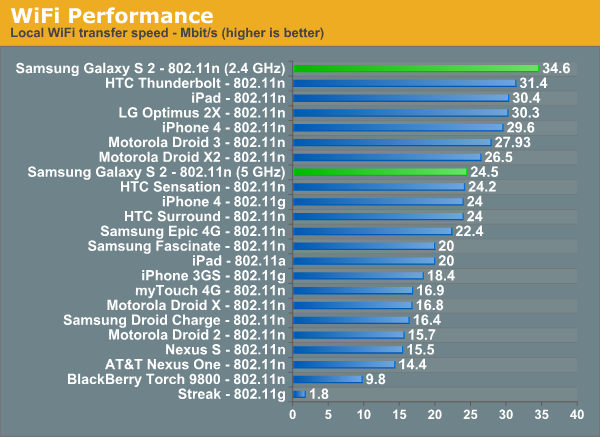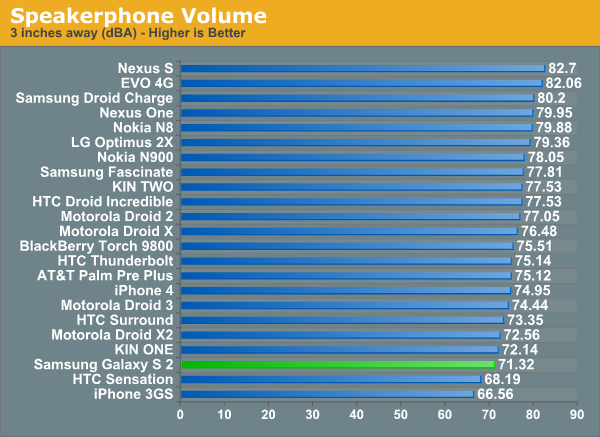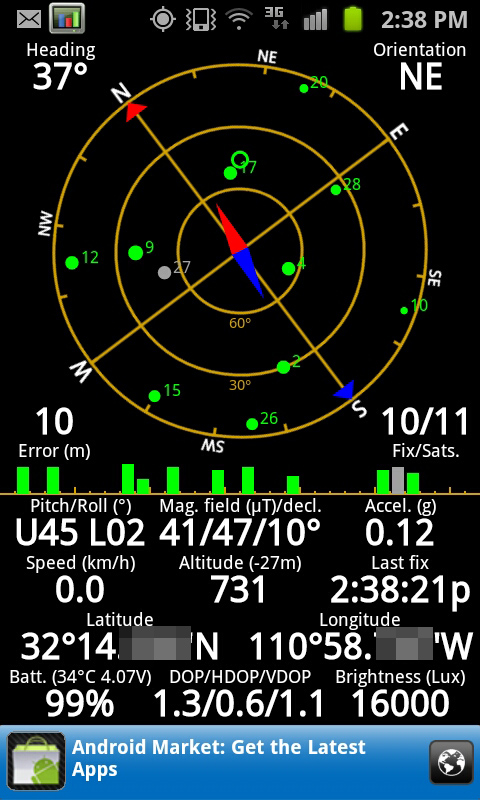Samsung Galaxy S 2 (International) Review - The Best, Redefined
by Brian Klug & Anand Lal Shimpi on September 11, 2011 11:06 AM EST- Posted in
- Smartphones
- Samsung
- Galaxy S II
- Exynos
- Mobile
WiFi, GPS
The SGS2 has both 2.4 and 5 GHz WiFi connectivity courtesy of Broadcom’s newest combo chip, the BCM4330. It is the logical successor to BCM4329, which we saw adopted darn-well almost universally in the previous generation, from the iPhone 4 to SGS1. BCM4330 still is a single spatial stream combo solution, but what’s different is that alongside Bluetooth 4.0+HS support is an on-chip power amp for 5 GHz WLAN in addition to last gen’s 2.4 GHz power amp (or another version which had both). There’s also still FM receive and transmit support.
That puts SGS2 in an incredibly small list of smartphones that include 5 GHz WLAN support, which is critical going forwards as the 2.4 GHz ISM band gets even more crowded. I’ll spare you my usual rant about how at every conference and trade show 2.4 GHz turns into a completely unusable nightmare.
As with every other radio, we have to do the receive sensitivity dance and make sure nothing is broken. I tested the SGS2 alongside an SGS 4G at my house with both an Airport Extreme (5th Gen) and WRT54G-TM boosted to 184 mW. SGS2 WiFi reception on 2.4 GHz is darn near identical to the previous generation.
There’s something deceptive about this however, and it’s that although Samsung has chosen to go the usual compressed-dynamic-range route with cellular bars, the WLAN bars seem to be more linearized. Thus where I’m used to seeing every other smartphone show max (until you’re right about to fall off), the SGS2 actually doesn’t lie to me and shows fewer bars. Until I ran around and looked at RSSI in dBm, I suspected SGS2 had WLAN sensitivity issues where there don’t appear to be any. One small thing I did notice is that SGS2 (and BCM4330) seems to only connect at long guard interval (eg 65 Mbps maximum for single stream, 20 MHz channels), where SGS1 and BCM4329 connected at 72 Mbps short guard interval.
In practice, actually using the 5 GHz radio on SGS2 is a bit challenging, since Android 2.x has no proper prioritization for 5 GHz over 2.4 GHz when presented with the same SSID running on both bands. I’d obviously like to see the less-crowded 5 GHz band used before the more crowded 2.4 GHz band.

Performance on 2.4 GHz with BCM4330 in SGS2 is scorching, at 34.6 Mbps when downloading a 100+ MB PDF over the local network. On 5 GHz performance drops a bit for some reason.
GPS
To say that SGS1’s GPS was a disaster is a bit of an understatement, at least on the variants that I got my hands on. What’s worse, for a lot of those phones, GPS is still broken to this day. Thankfully Samsung learned from that experience and didn’t make the same mistake twice, and SGS2 has a different GPS entirely and much better time to first fix as a result.
I mentioned it earlier, but SGS2 uses a SiRFstarIV GSD4t GPS this time around. It’s a bit interesting that Samsung is using a discrete GPS considering the fact that Exynos 4210 has its own integrated GPS baseband.
I measured time to a warm fix at around 3–5 seconds with the AGPS data already downloaded, which is pretty in line with modern devices. From a cold start, it’s anywhere between 10–15 seconds, though sometimes faster. I’ve seen faster on some other phones I won’t name, but GPS works this time around, and works well. I took the SGS2 on a 7-hour long road trip with me and used its GPS continually with no issues.
Call Audio
Inside the SGS2 is an Audience 1026 voice processor, which rejects noise which is common between the primary microphone at the bottom of SGS2 and secondary microphone at the top. Discrete noise canceling solutions are pretty par for the course lately, and it’s good to see SGS2 not excluded from that trend.
Inside the SGS2’s excellent ServiceMode menu is an option to enable and disable Audience processing, which naturally we explored. I recorded a call placed from the SGS2 in the presence of very loud background noise with Audience turned on and off, and you can hear the difference between the two, running through the same test. Only at the most extreme ambient volume level is background noise noticeable on SGS2.
Samsung Galaxy S II - Noise Rejection with Audience A1026 by AnandTech
Samsung Galaxy S II - Noise Rejection with Audience A1026 Disabled by AnandTech
Call quality on the SGS2 is a bit more interesting, I placed a test to the local ASOS and recorded it over line-in as we’ve done before. Inside ServiceMenu the device will even show what type of voice coder is used given present network conditions, which is AMR-NB on AT&T.
Samsung Galaxy S 2 - AMR-NB on AT&T by AnandTech
Here the SGS2 doesn’t sound quite as good as other phones I’ve recorded on UMTS, unfortunately.
Speakerphone Volume
Speakerphone is the last thing on the list, and unfortunately at maximum volume during a voice call, the SGS2 doesn't measure extremely well. This is puzzling, since for navigation and other system sounds, the SGS2 is very loud. Clearly something isn't set properly, and the SGS2 has the potential to be louder on speakerphone for calls with appropriate tweaking.














132 Comments
View All Comments
dagamer34 - Sunday, September 11, 2011 - link
On pg 15, Galaxy S uses a SGX 540 GPU, not 530. Other than that, great review!Synaesthesia - Sunday, September 11, 2011 - link
Staggering review, you really are the most comprehensive and scientific reviewer around, bravo!Samsung have really impressed with this phone, in terms of how much effort they have invested in the hardware and software. One thing still stands out for me, the battery life. While good, it still doesn't hold a candle to the iPhone 4, as shown on the charts.
LostViking - Saturday, September 17, 2011 - link
What do you mean?Its about 30% worse when web browsing (mostly because of the much larger screen I reckon), but better in the other tests.
If you are one of those old timers who actually use the phone for talking the SGSII is about 30 better ;)
When I am low on battery, and don't have access to a charger, that's usually what I would prioritize.
xdrol - Sunday, September 11, 2011 - link
For me the mentioned Cat 5 limit looks reasonable - you don't get user-level 2.0 Mbps because of the overhead of the PDCP/RLC/MACd protocols (about 15% -> 2.0 Mbps is 1.7 Mbps for IP).wilky76 - Sunday, September 11, 2011 - link
Alot of people that have the Samsung Galaxy S2 are suffering from framerate problems when using either 720p or 1080p in low light including myself.What basically happens is when the camera tries to focus in lowlight the framerates drop to around 13fps, then jump back upto around 30fps again, basically making any HD video recording useless in low light because of the stuttering, the only fix that is known is to drop the exposure to -2 as this stop the stuttering, or use 480p when indoors or poor light.
Some folks have returned their SGS2 because of this problem, only to receive another with the same problem.
There has been a couple of camera firmware updates on Samung own app site, which to this date still hasn't sorted the problem out & in some cases people that weren't suffering from this problem, now have it after updating the camera firmware.
Can any of you guys at Anandtech test your SGS2 in low light with either 720p or 1080p to see if the mobile you received for reviewing also suffer from this problem.
But what is strange is that not everbody has the framerate problem, so it could be due to which sensor you get with your SGS2, and could proberly be sorted with a firmware update eventually.
Anyways people with this problem and there is a few can be found in this post over at XDA
http://forum.xda-developers.com/showthread.php?t=1...
DrSlump - Monday, September 12, 2011 - link
Hi, i have exactly the same problem with my samsung galaxy s2.I got casual stuttering (a frame loss) during normal light conditions and severe stuttering under low light conditions.
As soon as the firmware raises the sensor gain to match the detected light, the framerate goes down to 25fps and when autofocus occours the framerate goes down to 13fps, and then returns back to 25fps when the autofocus is finished.
I olso noticed that when i try to frame a tv or a monitor, severe banding occours. Even taking a video when the light source is a tv or a monitor, banding occours. Seems like the isp isn't able to compensate the frequency of the light source.
In a lot of situations it's impossible to take a video due to the severe stuttering :(
Any one of you has these problems? How to solve it?
I would like to ask to the autor:
did you notice some problem with the display? There is a thread in the xda-developers forum that speaks about the yellow tinting or faded out left side of the screen. Please can you report about this problem?
B3an - Sunday, September 11, 2011 - link
Why dont you just admit it's the best phone around hands down? :) Not just the best Android phone. It's clearly miles superior to the outdated iPhone 4.Shame you yanks have had to wait forever to get it, only to get 3 different versions that dont even look as good and have ridiculous names. I've been using a GSII since April and it's just unmatched.
ph00ny - Sunday, September 11, 2011 - link
This yank got it on the UK launch day and i've been enjoying it sincesteven75 - Sunday, September 11, 2011 - link
It's not better in battery life, audio quality, display resolution and sharpness, or the many ways that iOS is better (AirPlay, app selection AND quality), immediate OS updates, etc).Gread Android phone though for those interested in 4.3" displays, which definitely isn't everyone. Personally, I'd wait for the Prime.
steven75 - Sunday, September 11, 2011 - link
Oh and outdoor display brightness, which even at 100% isn't a match for iPhone, but then it's even capped at 75% for temp reasons.